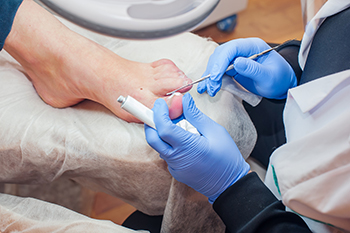Yellow, brittle, split, or thickened toenails are usually due to a fungal nail infection. There are a variety of microscopic organisms that can cause a fungal infection, which typically enter the nail through tiny cuts in the skin or between the nail bed and nail. A fungal toenail infection can be very difficult to get rid of at home, as the fungus can get in between the layers of nail and even deep under the nail in the nail bed. There are several things you can do to keep nails protected from these fungal invaders. First, never share personal items with anyone such as nail clippers, socks or towels: the fungus can live on these items for some time. The fungus can also stay viable for months in warm, moist environments such as communal showers, locker rooms, and pool areas, so you should always wear flip flops to avoid contact with surfaces in these areas. Avoid nail injuries by trimming your nails straight across—but not too short. Keep your feet clean and dry, change your socks daily, and allow wet sneakers or shoes at least a day to dry out before wearing them again. If you have developed a toenail infection, consult with a chiropodist who has professional level treatments to fully and permanently eradicate any toenail fungus.
Toenail fungus can be uncomfortable and unsightly. If you have diabetes or a compromised immune system, it may also be dangerous. To learn more about treatment options, please consult with Chiropodist Stephanie Poupore from North Bay Foot & Ankle. Our clinician will assess your condition and provide you with quality foot and ankle treatment.
What Does Toenail Fungus Look Like?
A fungal infection of the toenail may cause the affected nail to become thickened, brittle, crumbly, and yellowish or brown in color. Sometimes the toenail may separate from the nail bed, become deformed, emit a foul odor, or cause pain or discomfort.
What Causes Toenail Fungus?
Toenail fungus is caused by a fungus that infects the nail bed. The fungus lives and thrives in warm and moist environments and is also contagious. Athlete’s foot, which is a fungal infection of the skin, may spread to the nails and cause toenail fungus.
What Treatments Are Available?
Potential treatments for toenail fungus may include oral antifungal medications, topical antifungal medications, such as medicated nail polishes that are applied directly to the affected nail, and laser therapy. Sometimes, a combination of treatments is prescribed.
If you have any questions, please feel free to contact our office located in . We offer the newest diagnostic and treatment technologies for all your foot care needs.
Read more about Treating Toenail Fungus
